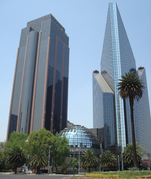Portal:Business
The Business and Economics Portal Business is the practice of making one's living or making money by producing or buying and selling products (such as goods and services). It is also "any activity or enterprise entered into for profit." A business entity is not necessarily separate from the owner and the creditors can hold the owner liable for debts the business has acquired. The taxation system for businesses is different from that of the corporates. A business structure does not allow for corporate tax rates. The proprietor is personally taxed on all income from the business. A distinction is made in law and public offices between the term business and a company such as a corporation or cooperative. Colloquially, the terms are used interchangeably. (Full article...) Economics (/ˌɛkəˈnɒmɪks, ˌiːkə-/) is a social science that studies the production, distribution, and consumption of goods and services. Economics focuses on the behaviour and interactions of economic agents and how economies work. Microeconomics analyses what is viewed as basic elements within economies, including individual agents and markets, their interactions, and the outcomes of interactions. Individual agents may include, for example, households, firms, buyers, and sellers. Macroeconomics analyses economies as systems where production, distribution, consumption, savings, and investment expenditure interact, and factors affecting it: factors of production, such as labour, capital, land, and enterprise, inflation, economic growth, and public policies that have impact on these elements. It also seeks to analyse and describe the global economy. (Full article...) Selected article The Austrian school is a heterodox school of economic thought that advocates strict adherence to methodological individualism, the concept that social phenomena result primarily from the motivations and actions of individuals along with their self interest. Austrian-school theorists hold that economic theory should be exclusively derived from basic principles of human action. The Austrian school originated in Vienna with the work of Carl Menger, Eugen von Böhm-Bawerk, Friedrich von Wieser, and others. It was methodologically opposed to the Historical school (based in Germany), in a dispute known as Methodenstreit, or methodology quarrel. Current-day economists working in this tradition are located in many countries, but their work is still referred to as Austrian economics. Among the theoretical contributions of the early years of the Austrian school are the subjective theory of value, marginalism in price theory and the formulation of the economic calculation problem, each of which has become an accepted part of mainstream economics. Selected image
Selected economyThe economy of Argentina is the second-largest national economy in South America, behind Brazil. Argentina is a developing country with a highly literate population, an export-oriented agricultural sector, and a diversified industrial base. Argentina benefits from rich natural resources. Argentina's economic performance has historically been very uneven, with high economic growth alternating with severe recessions, particularly since the late twentieth century. Income maldistribution and poverty have increased since this period. Early in the twentieth century, Argentina had one of the ten highest per capita GDP levels globally. It was on par with Canada and Australia, and had surpassed both France and Italy. Argentina's currency declined by about 50% in 2018 to more than 38 Argentine pesos per U.S. Dollar. As of that year, it is under a stand-by program from the International Monetary Fund. In 2019, the currency fell further by 25%. In 2020, it fell by 90%, in 2021, 68%, and a further 52% in 2022 (until July 20). (Full article...) Selected quote"The world economy, like the economy of a single country, can be visualized as a system of interdependent processes. Each process, be it the manufacture of steel, the education of youth or the running of a family household, generates certain outputs and absorbs a specific combination of inputs. Direct interdependence between two processes arises whenever the output of one becomes an input of the other: coal, the output of the coal mining industry, is an input of the electric power generating sector. The chemical industry uses coal not only directly as a raw material but also indirectly in the form of electrical power. A network of such links constitutes a system of elements which depend upon each other directly, indirectly or both. The state of a particular economic system can be conveniently described in the form of a two-way input-output table showing the flows of goods and services among its different sectors, and to and from processes or entities (“value added” and “final demand”) viewed as falling outside the conventional borders of an input-output system. As the scope of the inquiry expands, new rows and columns are added to the table and some of the external inflows and outflows become internalized. Increasing the number of rows and columns that describe an economic system also permits a more detailed description of economic activities commonly described in highly aggregative terms."
TopicsRelated WikiProjectsDid you know (auto-generated) -
On this day in business history
General imagesThe following are images from various business-related articles on Wikipedia.
More did you know
Business news
SubcategoriesRelated portals
Things you can doUrgent and important articles are bold
WikimediaThe following Wikimedia Foundation sister projects provide more on this subject:
SourcesDiscover Wikipedia using portals |







































